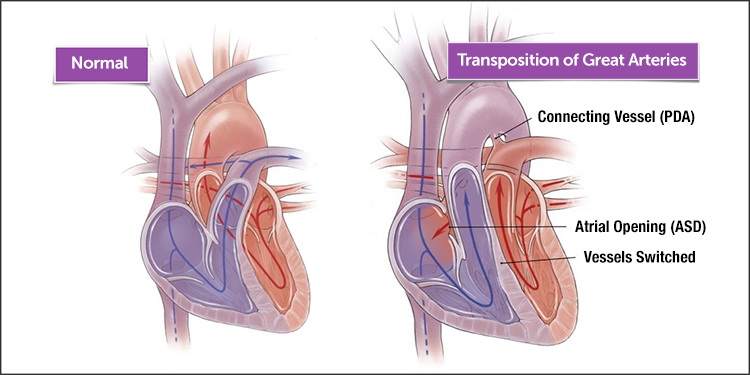Transposition of the Great Arteries | Symptoms & Causes
What are the symptoms of transposition of the great arteries?
The symptoms of transposition of the great arteries may include:
- Cyanosis (blue coloration of the skin)
- Shortness of breath
- Lack of appetite
- Poor weight gain
What causes transposition of the great arteries?
Transposition of the great arteries (TGA) is a congenital heart defect, which means children are born with it.
The heart forms during the first eight weeks of fetal development. The problems associated with TGA occur in the middle of these weeks, when the aorta and the pulmonary artery each attach to the incorrect heart chamber. It isn’t clear what causes congenital heart malformations, including TGA, although in most cases it appears that some combination of genetics and environment is involved.
Very few risk factors have been identified, but it appears that the risk of TGA is increased in mothers with type 1 diabetes mellitus (formerly known as "insulin-dependent" or "juvenile") and possibly with the ingestion of certain drugs, such as benzodiazepines.
Make an appointment
- Call us at 617-355-4278
- Email us at heart@childrens.harvard.edu
- Request a second opinion
Transposition of the Great Arteries | Diagnosis & Treatments
How is transposition of the great arteries diagnosed?
If, during pregnancy, a routine prenatal ultrasound or other signs raise suspicion of a congenital heart defect in the fetus, a cardiac ultrasound of the baby in uterowill usually be the next step. The cardiac ultrasound can usually detect transposition of the great arteries (TGA).
If your newborn baby was born with a bluish tint to his skin, or if your child is experiencing certain symptoms, your pediatrician will immediately refer you to a pediatric cardiologist, who will perform a physical exam. Your child’s doctor will listen to your baby’s heart and lungs, measure the oxygen level in his blood (non-invasively) and make other observations that help to determine the diagnosis.
For most patients, a echocardiogram (cardiac ultrasound) and chest x-ray is all that’s needed to form a diagnosis. But in certain circumstances, other tests may be necessary:
- Electrocardiogram (ECG or EKG)
- Cardiac catheterization
What are the treatment options for transposition of the great arteries?
After birth, a newborn with transposition of the great arteries (TGA) will be admitted to Boston Children's Hospital's cardiac intensive care unit (CICU). Initially, he or she may be placed on oxygen or a ventilator to help with breathing, and IV (intravenous) medications may be given to help the heart and lungs function more efficiently.
Once stabilized, the baby's treatments may include:
Medication: Doctors may administer an IV (intravenous) medication (prostaglandin E1) to keep open the infant's ductus arteriosus (the prenatal connection between the aorta and the pulmonary artery, which usually closes shortly after birth, but which is now important as an alternative pathway for blood flow).
Cardiac catheterization: Before TGA surgery, doctors may perform a cardiac catheterization procedure called balloon atrial septostomy to improve the mixing of oxygen-rich (red) blood and oxygen-poor (blue) blood. A special catheter with a balloon in the tip is used to create or enlarge an opening in the atrial septum (wall between the left and right atria).
Surgery: Within a baby's first two weeks, transposition of the great arteries is surgically repaired through a procedure called an “arterial switch.” While supported by a heart-lung machine, the aorta and pulmonary arteries are disconnected, then “switched” and reconnected to their proper ventricles.
As part of the procedure, the coronary arteries are transferred to the new aorta. In addition, any holes between the chambers of the heart are closed.
What is the long-term outlook for children with transposition of the great arteries?
The Benderson Family Heart Center team continues to refine their management of TGA and incorporate the latest innovations and research. Most children who've had TGA surgery recover and grow normally. Even so, your child will need periodic monitoring, since he or she may be at increased risk for arrhythmias, leaky valves, narrowing of the arteries and other heart issues.


